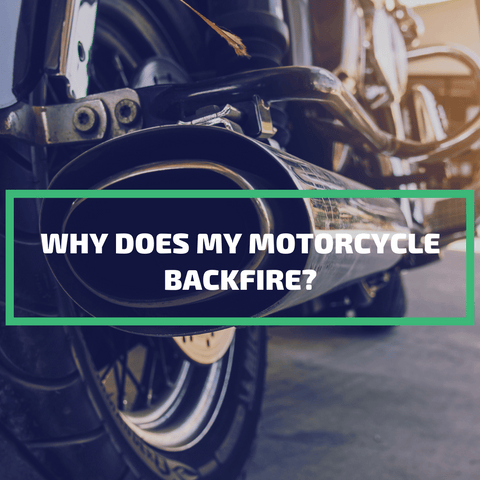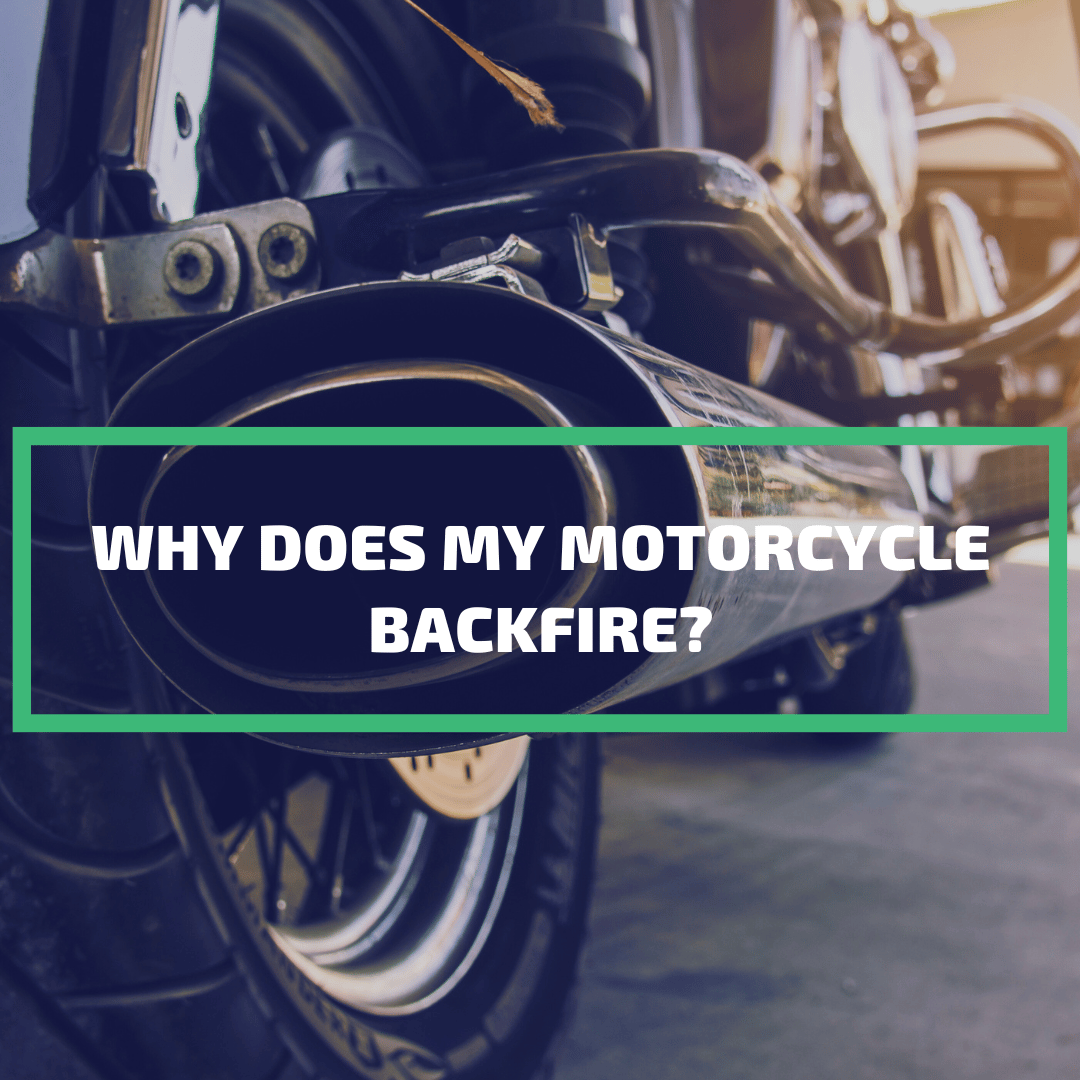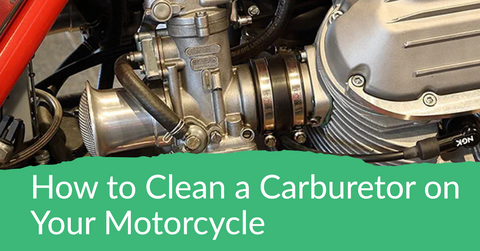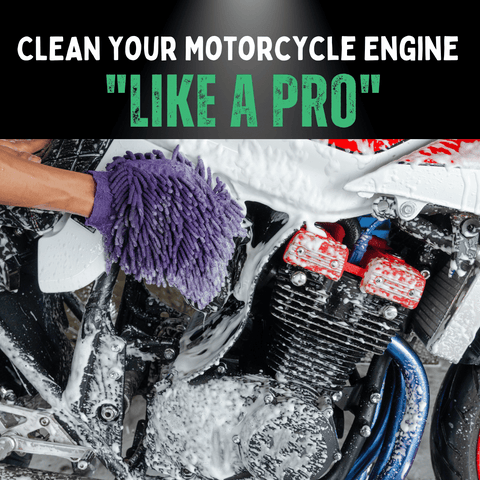Published: 14.7.23
Updated: 13.3.25
Have you ever cruised down the road on your motorcycle and heard a sudden pop sound, almost like a gunshot?
Well, that's your motorcycle backfiring. Quite the head-turner, isn't it? 
However, it's not as cool as it sounds - it's a sign of potential issues in your ride. If you're interested in learning more about motorcycles, check out this collection of kids motorcycles.
But why does your motorcycle backfire, and what can you do about it?
Let's get into it.
The Main Causes of Why Your Motorcycle Backfires
Motorcycle backfiring is a common issue that occurs when the combustion of fuel happens in the exhaust pipe instead of the engine. This can be caused by a variety of factors. Over-fueling or under-fueling, where there is too much or too little fuel respectively, can lead to backfiring. Loose exhaust pipes or the use of aftermarket exhausts can also contribute to this problem. Other potential causes include a malfunctioning fuel pump, an airbox leak, a faulty fuel filter, or a dirty carburetor. Each of these issues can disrupt the normal combustion process, causing the motorcycle to backfire.
Now that we understand what backfiring is let's delve into why it happens.
10 Causes of Motorcycle Backfire
Motorcycle backfires can be triggered by various issues. Below, we delve into ten possible causes.
For more information on motorcycles and their maintenance, you might find this guide on how to change the oil and oil filter on your motorbike or quad bike useful.
1. Rich-Running Engine (Excessive Fuel)
Poor fuel quality can exacerbate a rich-running engine condition. If the fuel contains too many impurities or incorrect octane levels, it can disrupt the combustion process and result in a backfire.
Why Does My Motorcycle Backfire When I Let Off The Throttle?
Motorcycles can backfire when you let off the throttle due to a sudden change in the air-fuel ratio.
As you release the throttle, the amount of air entering the engine decreases rapidly, but the fuel delivery might not decrease as quickly, causing an overly rich mixture and subsequent backfire.
Troubleshooting steps:
- Check fuel quality: Use recommended octane level fuel from reputable stations.
- Inspect fuel injectors: Look for clogged or leaking injectors.
- Test oxygen sensors: Use a multimeter to check for proper voltage output.
- Examine the fuel pressure regulator: Check for leaks or improper pressure.
2. Lean-Running Engine (Not Enough Fuel)
Similarly, a worn-out fuel injector can contribute to a lean-running engine.
The injector might not be able to deliver enough fuel, leading to improper combustion and, eventually, a backfire.
Troubleshooting steps:
- Adjust throttle cable tension: Ensure smooth operation without sticking.
- Clean or replace the air filter: A clogged filter can disrupt air flow.
- Check for vacuum leaks: Inspect intake manifold and hoses for cracks or loose connections.
- Verify proper fuel injector operation: Use an oscilloscope to check injector pulse width.
3. Motorcycle Backfire on Acceleration
Backfire during acceleration can occur due to an overly lean condition, where the engine gets more air than it needs for the amount of fuel delivered.
This could be due to several reasons, such as an air leak in the intake system or a malfunctioning fuel injector.
Troubleshooting steps:
- Check for air leaks in the intake system: Use a smoke machine to detect leaks.
- Verify mass airflow sensor readings: Use an OBD-II scanner to check sensor data.
- Inspect throttle position sensor: Test for proper voltage output at different positions.
- Examine fuel injectors for proper spray pattern: Use an injector flow tester.
4. Loose Exhaust Pipes and Headers
Deteriorating gasket seals in the exhaust system can lead to loose pipes and headers.
If the seals are not in good condition, they might not keep the system components firmly attached, allowing air leaks and backfire.
Troubleshooting steps:
- Visually inspect exhaust system: Look for gaps, rust, or damage.
- Check all exhaust fasteners: Tighten to proper torque specifications.
- Replace exhaust gaskets: Use high-quality gaskets designed for your model.
- Perform an exhaust leak test: Use soapy water or a smoke machine to detect leaks.
5. Ill-fitted Aftermarket Exhaust
Lack of proper guidance during installation can lead to an ill-fitted aftermarket exhaust.
Always consult an expert or refer to the product's manual to ensure correct fitment.
Troubleshooting steps:
- Verify exhaust compatibility: Ensure it's designed for your specific motorcycle model.
- Check all mounting points: Confirm proper alignment and secure attachment.
- Inspect for gaps or leaks: Use a flashlight to look for any visible openings.
- Perform a sound test: Listen for unusual exhaust noises indicating poor fitment.
6. Bad Fuel Pump
A fuel pump impacted by electrical issues can malfunction. For instance, if the relay that controls the pump has a fault, it could lead to an irregular supply of fuel, triggering a backfire.
Troubleshooting steps:
- Test fuel pump pressure: Use a fuel pressure gauge to verify proper output.
- Check fuel pump relay: Use a multimeter to test for continuity.
- Inspect wiring connections: Look for corrosion or loose connections.
- Verify fuel pump voltage: Ensure it's receiving proper power supply.
7. Airbox Leak
Cracked or deteriorated hoses connected to the airbox can lead to leaks.
These hoses should be inspected regularly for any signs of wear and replaced if necessary to prevent backfire.
Troubleshooting steps:
- Visually inspect airbox and connected hoses: Look for cracks or damage.
- Perform a smoke test: Use a smoke machine to detect small leaks.
- Check airbox seals: Ensure they're intact and properly seated.
- Verify airbox lid is secure: Check for proper closure and seal.
8. Bad Fuel Filter
Using lower-quality fuel can lead to a clogged fuel filter. Such fuel often contains more impurities, which can build up and block the filter, disrupting the air-fuel balance and causing a backfire.
Troubleshooting steps:
- Replace fuel filter: Use a high-quality filter recommended for your model.
- Inspect fuel lines: Look for any blockages or restrictions.
- Clean fuel tank: Remove any sediment or debris.
- Use fuel system cleaner: Add to tank to help remove deposits.
Related: Recognising Signs of a Dirty Engine Air Filter
9. Dirty Carburetor
Incorrectly adjusting the carburettor can lead to excess fuel in the combustion chamber.
This is why you should always follow the manufacturer's instructions when making adjustments.
Troubleshooting steps:
- Clean carburetor: Use a carburetor cleaner and compressed air.
- Adjust idle mixture screw: Follow manufacturer's specifications.
- Check float level: Ensure it's set to the correct height.
- Inspect jets for clogs: Clean or replace as necessary.
Related: A Step-by-Step Guide: How to Clean a Carburetor
10. Ignition Timing
Faulty ignition system components, like a malfunctioning ignition coil or distributor, can disrupt ignition timing.
Regular checks and timely replacement of these components can prevent backfire.
Troubleshooting steps:
- Check ignition timing: Use a timing light to verify proper timing.
- Inspect spark plug wires: Look for cracks or damage.
- Test ignition coil: Use a multimeter to check resistance.
- Verify distributor operation: Check for wear on rotor and cap.
11. Motorcycle Backfire at Idle
Backfiring at idle is often caused by problems with the ignition timing or a malfunctioning idle air control valve.
If the ignition timing is off, the fuel may ignite too early or late, causing backfire.
Troubleshooting steps:
- Clean idle air control valve: Remove and clean with appropriate solvent.
- Adjust idle speed: Set to manufacturer's specifications.
- Check for vacuum leaks: Inspect all vacuum lines and connections.
- Verify throttle position sensor operation: Test voltage output at idle.
12. Worn Out Spark Plugs
Inadequate emission control systems can lead to worn-out spark plugs.
For example, a malfunctioning EGR (Exhaust Gas Recirculation) system can lead to higher combustion temperatures, wearing out the spark plugs faster and causing a backfire.
Regular checks of the emission control systems can help prevent this issue.
Troubleshooting steps:
- Inspect spark plugs: Look for wear, deposits, or damage.
- Check spark plug gap: Adjust to proper specifications.
- Verify emission control systems: Use an OBD-II scanner to check for any related codes.
- Replace spark plugs: Use the type and heat range recommended by the manufacturer.
Related: Struggling with Pit Bike Backfires? Here's Your FIX!
Common Myths About Motorcycle Backfires
There are several misconceptions surrounding motorcycle backfires that can lead to misunderstandings about their causes and potential solutions.
Let's debunk some of these common myths:
| Myth | Fact |
|---|---|
| Loud pipes prevent backfires | Loud exhaust systems do not prevent backfires. They can make backfires more noticeable. |
| Backfires always indicate serious engine problems | Occasional backfires can be normal for some motorcycles, but frequent backfiring should be investigated. |
| All backfires are the same | There are different types of backfires, including exhaust and intake backfires. |
| Backfires are always harmful to the engine | Not all backfires are harmful. The impact depends on the frequency and cause. |
| Aftermarket exhausts always cause backfires | Proper installation and tuning can prevent backfires associated with aftermarket exhausts. |
By understanding these myths, riders can better diagnose and address backfire issues, leading to more effective motorcycle maintenance and improved riding experiences.
Remember, when in doubt, it's always best to consult with a professional mechanic to accurately diagnose and resolve backfire problems.
How to Stop Motorcycle Backfire
Preventing backfire mainly involves addressing the root causes listed above.
Regular maintenance, such as keeping the carburettor clean, checking and replacing the spark plugs, and ensuring the exhaust system and airbox are secure and leak-free, can help mitigate backfiring.
How to Stop Motorcycle Backfire
Preventing backfire mainly involves addressing the root causes listed above. Regular maintenance can help mitigate backfiring and keep your motorcycle running smoothly. Below is a downloadable checklist for regular maintenance to prevent backfire.
Download Maintenance ChecklistRegular Tune-Ups
Schedule maintenance checks every 3,000 to 5,000 miles or as recommended by your motorcycle's manufacturer. During these tune-ups, experts can identify and address potential issues before they lead to backfiring.
Precision Fuel Mapping
For fuel-injected motorcycles, professional tuners recommend precision fuel mapping. This process involves adjusting the fuel injection system to ensure optimal air-fuel ratios across all RPM ranges. Proper fuel mapping can significantly reduce the likelihood of backfire, especially when combined with aftermarket exhaust systems.
Advanced Ignition Timing Adjustment
Experienced mechanics stress the importance of correctly setting ignition timing. They often use advanced timing lights and diagnostic tools to ensure precise ignition timing. This can prevent pre-ignition and post-ignition issues that lead to backfire.
High-Quality Fuel and Additives
Professional riders often recommend using high-quality fuel and fuel additives. Premium gasoline with the correct octane rating for your motorcycle can prevent detonation issues. Some experts also suggest using fuel system cleaners periodically to keep injectors and carburetors clean.
Professional Exhaust System Installation
When installing aftermarket exhaust systems, professionals emphasise the importance of proper fitment and tuning. They often recommend dyno tuning after installation to ensure the engine's air-fuel mixture is correctly adjusted for the new exhaust flow characteristics.
Advanced Diagnostic Techniques
Professional mechanics use advanced diagnostic tools like oscilloscopes and exhaust gas analysers to identify subtle issues that might lead to backfire. These tools can detect problems with fuel injectors, oxygen sensors, and ignition systems that might not be apparent during a basic inspection.
Proactive Component Replacement
Experienced technicians often recommend proactively replacing components like spark plugs, fuel filters, and oxygen sensors before they fail. This preventive approach can help maintain optimal engine performance and reduce the risk of backfire.
By incorporating these professional tips into your motorcycle maintenance routine, you can significantly reduce the likelihood of backfire and ensure your bike performs at its best.
Remember, while many maintenance tasks can be performed at home, complex issues should always be addressed by certified professionals to ensure safety and optimal performance.
Is Backfiring Bad for a Motorcycle?
While an occasional backfire might not severely harm your motorcycle, consistent backfire is a sign that something is wrong with your engine.
Over time, these mini-explosions can damage the exhaust system and engine components, leading to costly repairs.
Persistent backfiring should not be ignored as it may cause significant damage over time.
Apart from the potential to damage the engine and exhaust system, constant backfiring can also reduce your bike's overall lifespan.
Plus, the inefficient combustion associated with backfiring can lead to poor fuel economy, ultimately costing you more at the petrol station.
If you're interested in the history of kids riding motorbikes and how it's evolved over time, you can read this article.
How to fix a motorcycle backfire caused by a rich-running engine
To fix a motorcycle backfire caused by a rich-running engine, you can follow these steps:
- Check the air filter: A dirty air filter can cause a rich condition by restricting airflow to the engine. If the air filter is dirty, clean or replace it.
- Check the carburettor: A dirty carburettor can also cause a rich condition. Remove the carburettor and clean it thoroughly with the carburettor cleaner.
- Check the fuel system: A malfunctioning fuel system can cause a rich condition. Check the fuel pump, fuel filter, and fuel injectors for any issues. Replace any faulty components.
- Adjust the carburettor: If cleaning the carburettor doesn't solve the problem, you may need to adjust the carburettor. Refer to your motorcycle's owner's manual for instructions on how to adjust the carburettor.
- Check the spark plugs: Worn-out spark plugs can cause incomplete combustion, leading to a rich condition. Check the spark plugs and replace them if necessary.
It's important to note that a rich condition can cause damage to your engine if left unchecked.
If you're not comfortable performing these steps yourself, it's best to take your motorcycle to a professional mechanic.
Related: 8 Proven Steps to CLEAN Your Motorcycle Engine Like a PRO
Professional Maintenance Tips to Prevent Backfire
Regular Tune-Ups
Professional mechanics emphasise the importance of regular tune-ups. Schedule maintenance checks every 3,000 to 5,000 miles or as recommended by your motorcycle's manufacturer. During these tune-ups, experts can identify and address potential issues before they lead to backfiring.
Precision Fuel Mapping
For fuel-injected motorcycles, professional tuners recommend precision fuel mapping. This process involves adjusting the fuel injection system to ensure optimal air-fuel ratios across all RPM ranges. Proper fuel mapping can significantly reduce the likelihood of backfire, especially when combined with aftermarket exhaust systems.
Advanced Ignition Timing Adjustment
Experienced mechanics stress the importance of correctly setting ignition timing. They often use advanced timing lights and diagnostic tools to ensure precise ignition timing. This can prevent pre-ignition and post-ignition issues that lead to backfire.
High-Quality Fuel and Additives
Professional riders often recommend using high-quality fuel and fuel additives. Premium gasoline with the correct octane rating for your motorcycle can prevent detonation issues. Some experts also suggest using fuel system cleaners periodically to keep injectors and carburetors clean.
Professional Exhaust System Installation
When installing aftermarket exhaust systems, professionals emphasise the importance of proper fitment and tuning. They often recommend dyno tuning after installation to ensure the engine's air-fuel mixture is correctly adjusted for the new exhaust flow characteristics.
Advanced Diagnostic Techniques
Professional mechanics use advanced diagnostic tools like oscilloscopes and exhaust gas analysers to identify subtle issues that might lead to backfire. These tools can detect problems with fuel injectors, oxygen sensors, and ignition systems that might not be apparent during a basic inspection.
Proactive Component Replacement
Experienced technicians often recommend proactively replacing components like spark plugs, fuel filters, and oxygen sensors before they fail. This preventive approach can help maintain optimal engine performance and reduce the risk of backfire.
By incorporating these professional tips into your motorcycle maintenance routine, you can significantly reduce the likelihood of backfire and ensure your bike performs at its best.
Remember, while many maintenance tasks can be performed at home, complex issues should always be addressed by certified professionals to ensure safety and optimal performance.
Latest Technologies to Prevent Motorcycle Backfire
As motorcycle technology continues to advance, manufacturers and aftermarket companies are developing innovative solutions to address common issues like backfiring.
Here are some of the latest technologies aimed at preventing motorcycle backfire:
Advanced Engine Control Units (ECUs)
Modern ECUs are becoming increasingly sophisticated, utilising complex algorithms and real-time data analysis to optimise fuel injection and ignition timing. These smart ECUs can adapt to various riding conditions, altitude changes, and fuel quality variations, significantly reducing the likelihood of backfire.
Adaptive Exhaust Systems
Some high-end motorcycles now feature electronically controlled exhaust valves that adjust based on engine speed and load. These systems help maintain optimal back pressure throughout the rev range, reducing the chances of unburnt fuel entering the exhaust system and causing backfire.
Knock Sensors and Detonation Control
Advanced knock sensors can detect pre-ignition or detonation events in real-time. When coupled with sophisticated engine management systems, they can adjust ignition timing and fuel mixture on the fly to prevent conditions that might lead to backfire.
Self-Learning Fuel Injection Systems
The latest fuel injection systems incorporate machine learning algorithms that continuously adapt to the rider's style and environmental conditions. These systems can fine-tune the air-fuel mixture more precisely than ever before, minimising the risk of running too rich or too lean – both conditions that can lead to backfire.
Active Intake Systems
Some manufacturers are implementing variable intake systems that adjust the length and volume of the intake tract based on engine speed. This technology helps optimise air flow across the entire rev range, ensuring a more consistent air-fuel mixture and reducing the likelihood of backfire.
Integrated Diagnostic Systems
New motorcycles are increasingly equipped with advanced onboard diagnostic systems that can detect potential issues before they lead to problems like backfire. These systems can alert riders to maintenance needs or potential malfunctions in real-time, allowing for proactive addressing of issues.
Smart Exhaust Temperature Management
Innovative exhaust systems now incorporate temperature sensors and cooling strategies to manage exhaust gas temperatures more effectively. By preventing excessive heat build-up in the exhaust system, these technologies can reduce the likelihood of fuel igniting in the exhaust and causing backfire.
AI-Powered Tuning Apps
Aftermarket companies are developing smartphone apps that use artificial intelligence to analyse engine performance data. These apps can suggest optimal tuning parameters to prevent issues like backfire, allowing riders to fine-tune their bikes more effectively.
While these technologies are making significant strides in preventing backfire and improving overall motorcycle performance, it's important to note that proper maintenance and adherence to manufacturer guidelines remain crucial.
As these innovations become more widespread and affordable, riders can look forward to smoother, more reliable performance from their motorcycles.
In Summary
In conclusion, if your motorcycle backfires, don't ignore it. Identifying the root cause and rectifying it not only enhances your ride's performance but also prolongs its lifespan.
If you're interested in different types of ride-on motorbikes for kids, you can check out these collections of kids petrol ride-on motorbikes and kids electric ride-on motorbikes.
Remember, a happy bike makes a happy ride!
FAQs
How do you diagnose a lean-running engine causing motorcycle backfire
To identify a lean-running engine causing motorcycle backfire, do the following: Inspect the air filter and replace it if it's dirty. Examine the fuel system and replace any defective parts. Look for air leaks in the intake system and repair them. Clean the carburettor if it's clogged. Finally, inspect and change worn-out spark plugs. If these tasks seem daunting, take your bike to a professional mechanic to prevent engine damage.
How do you prevent motorcycle backfire when using an aftermarket exhaust?
To prevent backfiring with an aftermarket exhaust, pick the right exhaust for your motorcycle model. After installation, get a tune-up for optimal engine performance. Consider installing a fuel controller to maintain the correct air/fuel ratio and check for air leaks in the intake system. Also, fitting a spark arrestor can help trap sparks that may trigger backfire. If backfire persists, consult a professional mechanic.
How do you adjust the air-fuel mixture on a motorcycle to prevent backfire?
Get in Touch
We hope you found this article helpful! If you have any further questions about kids' ride-on toys, the team at RiiRoo is here to assist you.
Visit our website at www.riiroo.com to explore our wide range of products and informative articles.
If you prefer a more direct approach, feel free to reach out to us via our Live Chat feature or send an email to hello@riiroo.com.
We're always ready to help you make the best choice for your little ones.
Remember, at RiiRoo, your child's fun and safety are our top priority!











Share:
How Fast Are 250cc Motorcycles? The Top Speed In MPH
What Are the Best Go-Kart Gear Ratios? (UPDATED 2025)